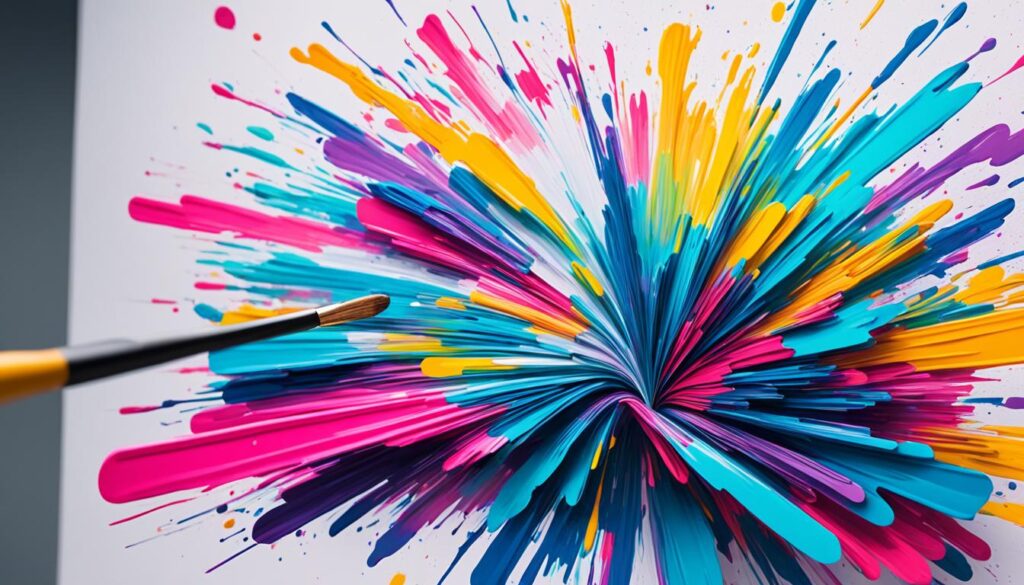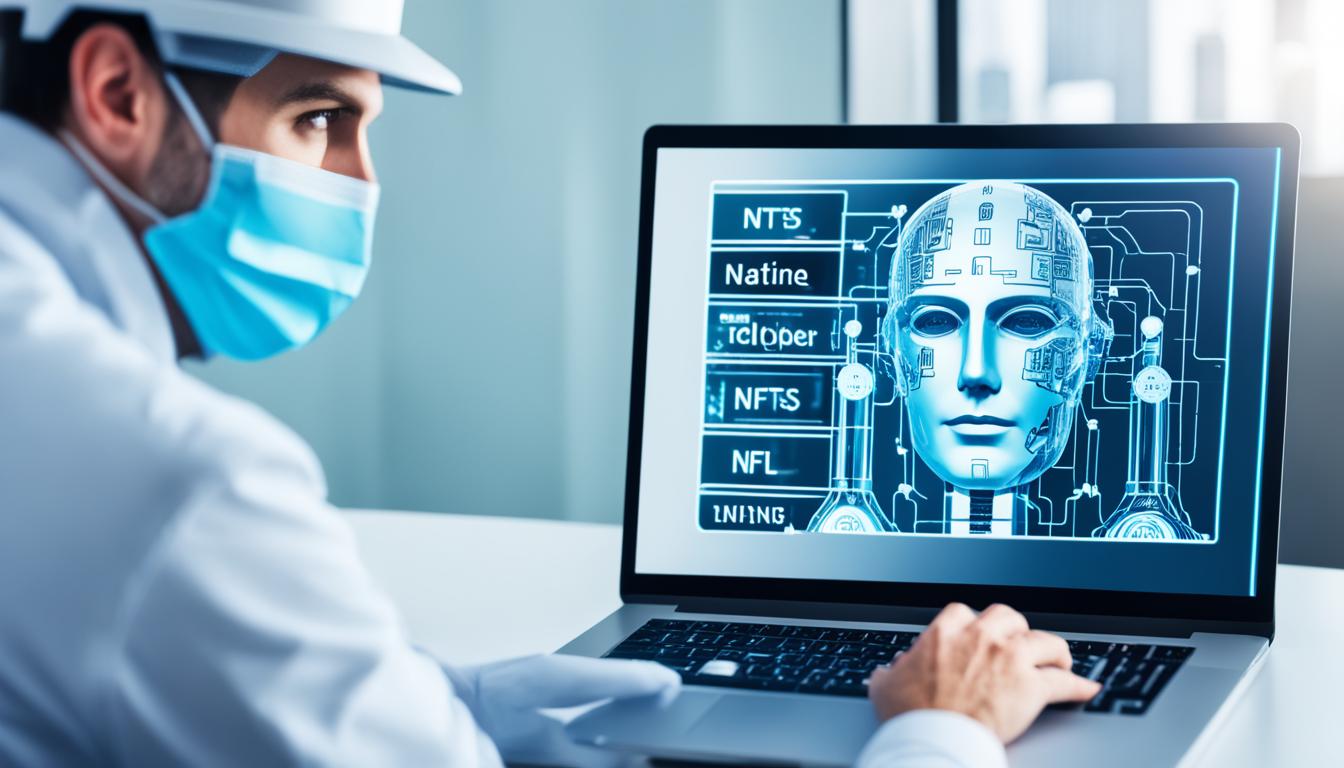Did you know that the global NFT market reached a staggering $338 million in the first quarter of 2021 alone? The combination of blockchain technology and artificial intelligence (AI) has revolutionized the way we perceive and interact with digital assets. In this article, we’ll explore how AI is transforming the world of NFTs, from the creation and verification of unique digital assets to the future of the digital art landscape.
Key Takeaways:
- AI-powered algorithms such as GANs are capable of autonomously generating unique and dynamic digital assets in the form of AI-generated NFTs.
- Prompt engineering and generative AI play a crucial role in the creation, quality regulation, and verification of NFT art.
- The fusion of NFTs and AI has the potential to improve the user experience, provide personalized recommendations, and reduce risks of deception in the NFT market.
- Despite challenges, the combination of NFTs and AI opens up new possibilities for creators, collectors, and enthusiasts, shaping the future of the digital art landscape.
- The influence of AI on the NFT ecosystem continues to evolve and redefine how we perceive and interact with digital assets.
The Potential of AI in NFTs: Unleashing Creativity and Unique Digital Assets
Artificial intelligence (AI) has made waves in various industries, and now it has permeated the world of non-fungible tokens (NFTs). AI-powered algorithms, like Generative Adversarial Networks (GANs), have the ability to autonomously generate digital art and assets. This means that AI can create visually stunning, unique, and unpredictable visuals by analyzing vast datasets. AI generative art is quickly gaining popularity in the NFT space, as it pushes the boundaries of human imagination.
Unlike traditional art, which is typically created by human artists, AI-generated NFTs offer a level of novelty and creativity that is hard to replicate. These digital assets are not only one-of-a-kind but also dynamic, capable of evolving over time and responding to user interactions. The marriage of AI and NFTs presents an exciting opportunity to explore new realms of creativity and innovation in the digital art world.
By harnessing generative algorithms, AI can generate an infinite number of unique artworks, each with its own distinct characteristics. This not only adds value to the artwork but also creates a sense of exclusivity for collectors and enthusiasts. The use of AI in NFTs opens up a new realm of possibilities, allowing artists to experiment with unconventional ideas and challenge traditional artistic norms.
Furthermore, AI-generated NFTs have the potential to disrupt the art market by offering a new level of transparency and trust. Through AI-powered algorithms, the authenticity and uniqueness of digital assets can be verified, ensuring that buyers are investing in genuine and original creations. This verification process helps combat issues such as plagiarism and counterfeit art, providing a more secure marketplace for both artists and collectors.
AI in NFTs: Redefining the Artistic Landscape
In the digital art landscape, AI has the power to revolutionize the way we create, experience, and interact with art. It challenges traditional notions of authorship and expands the possibilities of what art can be. AI-generated NFTs blur the lines between humans and machines, resulting in a fusion of creativity and technology.
The uniqueness and unpredictability of AI-generated NFTs make them particularly appealing to collectors and investors. Each piece of AI art is an original creation, with no two artworks being exactly alike. This exclusivity adds value and scarcity to the digital assets, making them highly sought after in the NFT market.
“AI-generated NFTs are not just static images; they are living pieces of art that evolve and respond to their environment. This dynamic element adds a new layer of interaction and immersion for the audience.”
Moreover, AI-generated NFTs can go beyond visual art, expanding into other mediums such as music, literature, and virtual reality. These multidimensional creations provide a truly immersive and interactive experience for the audience, pushing the boundaries of what is possible in the digital art space.
With AI at the helm, artists are no longer limited by their own imagination. Instead, they can collaborate with AI algorithms to explore uncharted territories and tap into new sources of inspiration. AI opens up a world of possibilities, where creativity knows no bounds.
| Advantages of AI in NFTs | Challenges of AI in NFTs |
|---|---|
|
|
The Role of AI in NFT Art: Creation, Quality Regulation, and Verification
The rise of AI in the NFT art world has brought significant advancements in the creation, quality regulation, and verification of digital art assets. AI technologies such as prompt engineering and generative AI play a crucial role in shaping the landscape of AI-generated NFT art.
Prompt Engineering: Guiding AI Creativity
Prompt engineering involves the development and improvement of text prompts used by automatic language processing models. By carefully crafting prompts, AI algorithms can generate unique and creative artwork that aligns with specific desired outcomes. This technology enables artists and collectors to harness the power of AI to create art that pushes the boundaries of human imagination.
Generative AI: A New Era of Artistic Creation
Generative AI algorithms, driven by principles and parameters, have the ability to autonomously create images and other media. These algorithms analyze vast datasets, allowing AI to produce art that is both unique and unpredictable. By leveraging generative AI, artists can explore new artistic possibilities and create digital assets that captivate audiences with their novel and imaginative designs.
Ensuring Quality and Authenticity
AI not only facilitates the creation of NFT art but also plays a critical role in ensuring its quality and authenticity. By analyzing blockchain history and content, AI algorithms can verify the legitimacy of NFT artwork, reducing the risks of deception and counterfeit art in the market. This provides collectors and buyers with confidence and trust in the NFT art they acquire.
Improved Search Results and Personalized Recommendations
The integration of AI in the NFT art market enhances the user experience by delivering improved search results and personalized recommendations. AI algorithms can analyze user preferences, historical data, and market trends to provide tailored recommendations that match individual tastes. This personalized approach enables users to discover and acquire NFT art that aligns with their specific interests and preferences.
| Benefits of AI in NFT Art | Implications |
|---|---|
| Enhanced creativity and innovation | Pushes the boundaries of traditional art |
| Improved quality control | Reduces the presence of counterfeit art |
| Enhanced user experience | Personalized recommendations and tailored discovery |
| Greater trust and authenticity | Verified and legitimate NFT artworks |
As AI continues to evolve, its role in the NFT art world will become more prominent. The combination of prompt engineering, generative AI, and verification mechanisms ensures a reliable and authentic NFT art marketplace. With AI as a driving force, NFT art opens up new possibilities for creativity, quality control, and personalized experiences, transforming the way we perceive and interact with digital art.

Conclusion: The Future of NFTs and AI in the Digital Art Landscape
As the digital art community continues to expand, the fusion of NFTs and AI will play a crucial role in shaping the future of the industry. The combination of AI’s analytical capabilities and NFTs’ representation of digital assets opens up new possibilities for creators, collectors, and enthusiasts.
AI has the potential to revolutionize the creation, purchase, and sale of non-fungible tokens by analyzing and verifying digital assets and providing insights into consumer preferences. By leveraging AI algorithms, the NFT ecosystem becomes more efficient, streamlined, and secure, enhancing the overall user experience.
While there may be challenges with an overcrowded market and the potential lack of creativity in AI-generated NFTs, the rise of AI in the NFT art world opens up new avenues for exploration and expression. Artists can harness the power of AI to augment their creative process, creating unique and innovative digital artworks. Moreover, collectors can discover and engage with a diverse range of AI-generated NFTs, further expanding the boundaries of what is considered valuable in the art world.
The influence of AI on the NFT ecosystem will continue to evolve and redefine how we perceive and interact with digital art. As technology advances and AI algorithms become more sophisticated, the future of NFTs holds tremendous potential for both creators and consumers. By embracing the integration of AI in digital art, we can unlock new levels of creativity, enhance user experiences, and shape the future landscape of NFTs.

Leave a Reply